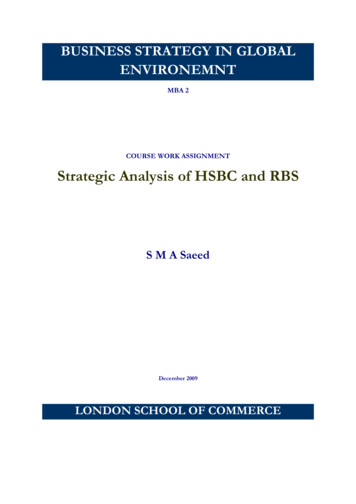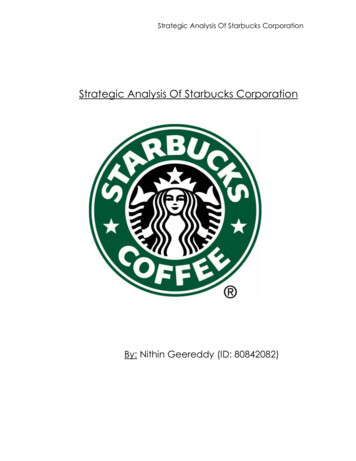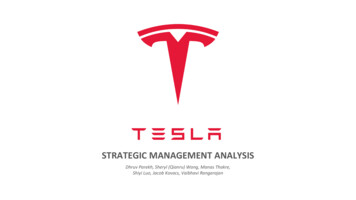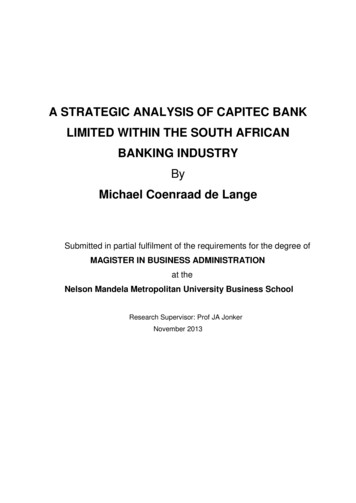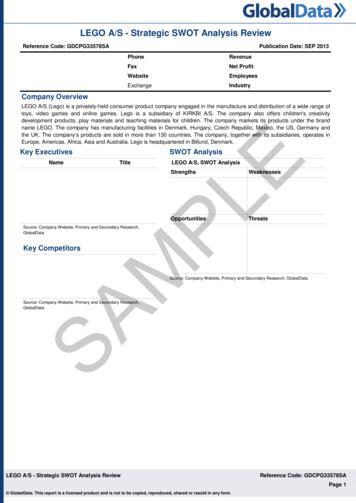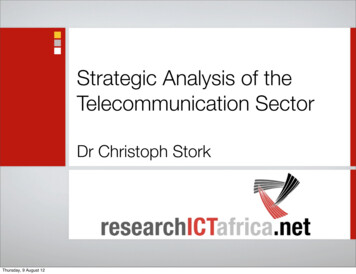
Transcription
Strategic Analysis of theTelecommunication SectorDr Christoph StorkThursday, 9 August 12
Country LevelPESTEL: Political, Economic, Social, Technological, Environmental, LegalSector LevelFive Competitive ForcesCompetitor LevelGeneric StrategiesSWOT Analysis: Strength, Weakness, Opportunity, ThreatThursday, 9 August 12
PESTEL AnalysisThursday, 9 August 12
PESTEL AnalysisOverview of the different macro-economic and environmentalfactorsUseful strategic tool for understanding market growth ordecline, business position, potential and direction forinvestmentFactors vary in importance based on goods or servicesoffered: Telecommunication sector vs agriculture produce egThursday, 9 August 12
Political: to what degree agovernment intervenes in the economyShare of SOE to GDPTax policyTrade restrictionsTariff regulationPolitical stabilityOwnership limitationsThursday, 9 August 12
EconomicEconomic growth (GDP growth)Interest rates (cost of capital)Exchange rates (costs of exporting goods and thesupply and price of imported goods)Purchasing power of potential customersInflation rateWork force productivityThursday, 9 August 12
SocialDemographic aspects: population growth rate, age distributionAgeing population has a different demand compared to young populationCultural aspects (various management strategies to adapt to it)Women in management in Islamic countriesPublic HolidaysEating habits and rulesHealth aspectsWeakening of workforce through disease (HIV/AIDS, Malaria)Safety regulationsThursday, 9 August 12
TechnologicalTechnological factors can lower barriers to entry, reduceminimum efficient production levels, and influenceoutsourcing decisions.R&D activityAutomationtechnology incentives and the rate of technological change(3G to 4G)Thursday, 9 August 12
Environmentalweather (humidity may be a problem forpower generation)ClimateTopography (mountains, water influence radiowaves)Thursday, 9 August 12
LegalConsumer lawsCompetition and antitrust lawsLabour lawsHealth and safety laws and regulationsThursday, 9 August 12
Porter: 5 forcesThursday, 9 August 12
Application Telecom Sector: FiveForcesFive Force Model canbe used to analyse theattractiveness of anindustry from astrategic investmentperspectiveIt can also be used toassess the need forregulatory supervisionThursday, 9 August 12
Threat of new competition: Barriers to entryProfitable markets that yield high returns will attract new firms (MTCEBITDA margin - TN wants in on this)Many new entrants, which eventually will decrease profitability for all firms inthe industry unless there are barriers to entry:Patents and rights (site rights)Licenses market restriction by CRAN51% Namibian ownership requirementExisting mobile network coverage and technologies Existing fibre and copper network of TNBrand Loyalty - 081 nation Absence of number portabilitySwitching costs of postpaid customers (contract durations, keeping number etc.Capital requirements: (eg 1 billion N to compete with MTC’s network, (probably also 1 billionN to replicate TN fibre and copper network)Access to distribution (selling airtime through shebeens anywhere in the country)Industry profitability; the more profitable the industry the more attractive it will be to newcompetitors. Fixed line?Labour costSpectrum availabilityThursday, 9 August 12
Bargaining power of customers - ability ofcustomers to put the firm under pressureCustomer's price sensitivityBuyer concentration to firm concentration ratioother of operators to choose fromDegree of dependency upon existing channels of distributionBargaining leverage, particularly in industries with high fixed costsBuyer switching costs relative to firm switching costs:Cost of acquiring a new customer vs cost of new SIM card?Buyer information availability: able to judge which product is thecheapestDifferential advantage (uniqueness) of industry products:iPhoneBlack Berry (prepaid)Thursday, 9 August 12
Threat of substitute products or servicesThe existence of products outside of the realm of the common productboundaries increases the propensity of customers to switch to alternativesNot competitors' similar products but entirely different ones insteadtap water - Coke, not Pepsi: increased marketing for drinking tapwater might "shrink the pie" for both Coke and PepsiDVD rentals: not DSTV or streaming - but good weather, going for awalkNot contact lenses vs glasses but vs eye operations etc. More eyeoperations paid for medical aids will reduce the market for classes andcontact lensesBuyer propensity to substituteRelative price performance of substituteBuyer switching costs and ease of substitutionPerceived level of product differentiationNumber of substitute products available in the marketThursday, 9 August 12
Bargaining power of suppliersPresence of substitute inputstelecommunications equipment - Siemens, Nokia,Huawei, ZTEBargaining power of employees - trade unionsSuppliers may refuse to work with the firm, or, e.g., chargeexcessively high prices for unique resourcesSupplier switching costs relative to firm switching costsServices (consulting, technical, billing)Strength of distribution channel of suppliers (sole importrights)Supplier concentration to firm concentration ratioElectricity- Nampower, alternative diesel or solarThursday, 9 August 12
Intensity of competitive rivalryIntensity of competitive rivalry is the major determinant of thecompetitiveness of the industryMTC monopoly vs MTC during Competitionuntil 2006 lagging behind South AfricaSince 2007/8 leading by farSustainable competitive advantage through innovation,installing latest technology such as LTEPowerful competitive strategy: constant ARPU or flat rateHow to judge the competition within a sector?Price changesAggressiveness of marketing campaigns- claim to be cheapestor bestNumber of promotionsThursday, 9 August 12
Generic StrategiesThursday, 9 August 12
Porter's Generic StrategiesCost and price leadershipRisk of being stuck in the middleQuality of service:Coverage, dropped callsThursday, 9 August 12
Cost and price leadershipHigh volume low marginHigher volumes reduce to unit cost - economies of scaleEfficiency in network set up, billing, distribution channel etcThursday, 9 August 12
Quality of Service: Best networkLower volume -higher margin and or higher priceLess customers for same infrastructureFaster data ratesBetter voice qualityBester customer service at retail outletsThursday, 9 August 12
Alternative: Market SegmentationExample MTCT49- cheapest prepaid product (bottom end)4G LTE best mobile data product (high end)Thursday, 9 August 12
SWOT AnalysisThursday, 9 August 12
SWOT AnalysisInternal: Strength and WeaknessesExternal: Opportunities and ThreatsFirm specific not sector specific compared to the 5forces modelKnow your self and know your competitorsThursday, 9 August 12
StrengthA firm's strengths are its resources and capabilities that can be used as abasis for developing a competitive advantage. Examples of such strengthsinclude:Patents, know how,Strong brand namesGood reputation among customersCost advantagesFavourable access to distribution networksHappy and motivated work forceThursday, 9 August 12
WeaknessesThe absence of certain strengths may be viewed as a weakness:Weak brand namePoor reputation among customersHigh cost structurelack of access to key distribution channelsDisgruntled work forceHeavy relaince on outside expertiseIn some cases, a weakness may be the flip side of a strengthHigh production capacity vs to big to reacting quickly to changes in thestrategic environmentFew customer better data service but higher cost per customerThursday, 9 August 12
OpportunitiesNew opportunities for profit and growthunfulfilled customer need: dataarrival of new technologies: LTE, fibre to homeloosening of regulations: new licences, converged licencesremoval of international trade barriers: Voip providers inNamibiaThursday, 9 August 12
ThreatsThe flip side of opportunities may be threatsshifts in consumer tastes away from the firm's products: fixedmobile substitutionemergence of substitute products: Facebook to SMSnew regulations - new competitorsThursday, 9 August 12
StrategiesS-O strategies: pursue opportunities that are a good fit to thecompany's strengthsW-O strategies: overcome weaknesses to pursueopportunitiesS-T strategies: identify ways that the firm can use its strengthsto reduce its vulnerability to external threatsW-T strategies: establish a defensive plan to prevent the firm'sweaknesses from making it highly susceptible to externalthreatsThursday, 9 August 12
Conclusion: Know the country,the sector your competitors andyour own companyThursday, 9 August 12
Five Competitive Forces Country Level Sector Level Competitor Level Generic Strategies SWOT Analysis: Strength, Weakness, Opportunity, Threat Thursday, 9 August 12. PESTEL Analysis Thursday, 9 August 12. PESTEL Analysis Overview of the different macro-economic and environmental factors Useful strategic tool for understanding market growth or decline, business position, potential and direction .


